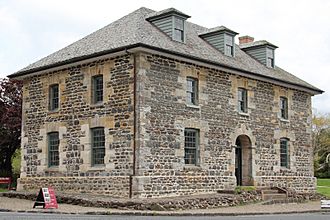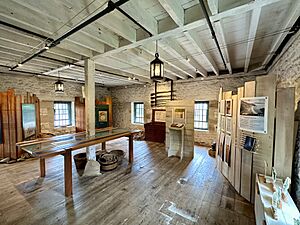Stone Store facts for kids
Quick facts for kids Stone Store |
|
|---|---|
 |
|
| General information | |
| Architectural style | Georgian |
| Location | Kerikeri basin |
| Address | 246 Kerikeri Road |
| Town or city | Kerikeri |
| Country | New Zealand |
| Coordinates | 35°13′04″S 173°57′46″E / 35.2177782°S 173.96267039999998°E |
| Construction started | 1832 |
| Completed | 1836 |
| Design and construction | |
| Architect | John Hobbs |
| Designated: | 23 June 1983 |
| Reference #: | 5 |
The Stone Store is a very old and special building in New Zealand. It's the oldest stone building there that is still in great shape! It was built a long time ago, between 1832 and 1836. A group called the Church Missionary Society built it in a place called Kerikeri. It was designed by John Hobbs to be a warehouse, which is like a big storage building.
Because the Stone Store was built so well, it was kept even after the Church Missionary Society became less active. Later, the New Zealand Historic Places Trust bought the building. Today, it is a popular place for tourists to visit. The Stone Store is recognized as a very important historical building by Heritage New Zealand.
Contents
What is the Stone Store?
The Stone Store is a two-story building. It was built as a warehouse. It has a special design called Georgian style. The building is made from local basalt stone. It also uses sandstone that came all the way from Parramatta and Sydney in Australia.
How the Stone Store Was Built
The Church Missionary Society started a settlement in Kerikeri in 1819. Kerikeri was an important base for other missions nearby. The Stone Store was built to hold goods that were made locally and things brought in from other countries.
John Hobbs created the design for the warehouse. During construction, a clocktower and a bell were added to the plans. However, these were taken off the building before 1858. The Stone Store was built from 1832 to 1836. Local Māori people helped with the basic work. The mission also provided skilled builders. James Kemp was in charge of the building project.
The Stone Store's Many Uses
After a while, fewer people lived in Kerikeri. The mission station became less important. But the Stone Store was still used! For example, it held the library of George Augustus Selwyn, who was the Bishop of New Zealand. This was when he was working with the mission at Te Waimate. During a conflict called the Flagstaff War, the building was even used to store weapons.
The Kerikeri mission closed in 1848. After that, the building was rented out. It was used for many different things over the years. It served as a post office, a school for Māori children, and a general store. In 1893, the Kemp family bought the building. They continued to rent it out. It was even used as a place to vote and as a boxing ring!
As more tourists started visiting Kerikeri, the Stone Store became a self-service shop in 1958. This meant people could pick out what they wanted and pay for it themselves.
In 1975, the New Zealand Historic Places Trust bought the building. They have taken care of it ever since.
Why the Stone Store is Important
The Stone Store is very important, not just in New Zealand but around the world. It shows how the Church Missionary Society worked. It also tells us about early international trade. The building even used sandstone brought from Australia!
It is connected to important people from colonial times. It also represents one of the earliest connections between European settlers and Māori people. Most importantly, it is the oldest stone building in New Zealand that is still in perfect condition.
Because of its long and interesting history, the Stone Store is listed as a Category 1 building by Heritage New Zealand. This means it is one of the most important historical places in the country.


